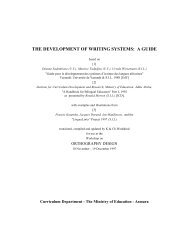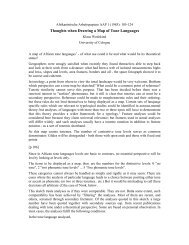2006 On the Survival of the Classical Kithara/Lyre in N.E.Africa
2006 On the Survival of the Classical Kithara/Lyre in N.E.Africa
2006 On the Survival of the Classical Kithara/Lyre in N.E.Africa
- No tags were found...
Create successful ePaper yourself
Turn your PDF publications into a flip-book with our unique Google optimized e-Paper software.
<strong>On</strong> <strong>the</strong> survival <strong>of</strong> <strong>the</strong> classical „kithara/lyre“<strong>in</strong> N.E. <strong>Africa</strong>‘s „krar/kisir/mas<strong>in</strong>koob/tambour“
The Claim:1. Claim: Europe lost <strong>the</strong> lyre – it survives <strong>in</strong> N.E. <strong>Africa</strong>2. Contacts <strong>of</strong> Cultures <strong>in</strong> <strong>the</strong> Roman Empire 200 A.D.3. Conservative Cultures <strong>in</strong> N.E.<strong>Africa</strong>- Beja- Ethiopia4. <strong>Kithara</strong> & <strong>Lyre</strong>- Shapes- Terms- Areas5. Technique6. Music Samples- Beja- Ethiopia7. Claim discussed d – Instruments t played
The Claim:• Today‘s musical practice answers questionswhich classical studies can‘t t, such as:• Do <strong>the</strong> mosaics reflect actual reality, or just iconography?• (Both <strong>of</strong> <strong>the</strong>se– not just iconographic stereotypes)• What exactly was <strong>the</strong> technique – left hand, right hand?• (The left hand plucks, <strong>the</strong> right hand beats)• How man str<strong>in</strong>gs were <strong>the</strong>re – given all those modes?• (Most likely around 6)• Did every str<strong>in</strong>g sound just one pitch or several?• (Just one. To start a different mode, re-tune)• How were <strong>the</strong> str<strong>in</strong>gs tuned?• (Us<strong>in</strong>g different mechanisms)
There are >200Orpheus mosaicsE.g. Mytilene Aisne Vienne Rottweil• But <strong>the</strong>ir musicologicali l<strong>in</strong>terpretation isproblematic• Some <strong>in</strong>terpretations don‘tstand a simple test <strong>of</strong>technical feasibility
In Europe, <strong>the</strong> tradition is lostA few traces are left• E.g., <strong>the</strong> column with<strong>the</strong> song <strong>of</strong> Seikilos,200 A.D.(time <strong>of</strong> <strong>the</strong> mosaics)
There was a revival <strong>of</strong> <strong>the</strong> ”<strong>Lyre</strong>“around 1920 - Ireland
In Europe, lyres died c. 1000 ADA.D.• <strong>On</strong>e <strong>of</strong> <strong>the</strong> last relics is a6-str<strong>in</strong>ged lyre <strong>of</strong>about 600 A.D.• Grave <strong>of</strong> a musiciannear Tuttl<strong>in</strong>gen
1. Claim: Europe lost <strong>the</strong> lyre - it survives <strong>in</strong> N.E. <strong>Africa</strong>2. Contacts <strong>of</strong> Cultures <strong>in</strong> <strong>the</strong> Roman Empire 200 A.D.3. Conservative Cultures <strong>in</strong> N.E.<strong>Africa</strong>- Beja- Ethiopia4. <strong>Kithara</strong> & <strong>Lyre</strong>- Shapes- Terms- Areas5. Technique6. Music Samples- Beja- Ehhiopia7. Claim discussed d – Instruments t played
The world around 200 A.D.as Romans saw it (Peut<strong>in</strong>ger map)• Part <strong>of</strong> <strong>the</strong> sameworld:• Roman mosaic <strong>in</strong>“Arae Flaviae“• Mediterranean• Nile
The world around 200 A.D.as Europeans saw it (Alamanni)• Part <strong>of</strong> <strong>the</strong> sameworld:• Alamanni• Aegyptus– sou<strong>the</strong>rnmosttRoman provice• Blemmyes (Beja)– east <strong>of</strong> <strong>the</strong> Nile(not west)
The world around 200 A.D.as Ethiopians (Axumites) saw it• Relations with:• Greece• Rome• Egypt• Beja (Blemmyer)
Indicators <strong>of</strong> cultural contactEthiopia (Axum) – Rome?• Ethiopia:Orix <strong>in</strong> <strong>the</strong> Afar area• Roman Mosaic:Orix horns on a lyre
Indicators <strong>of</strong> cultural contactEthiopia (Axum) – Greece?• Greek <strong>Lyre</strong>turtle body• Ethiopian <strong>Lyre</strong> - turtle ornament
1. Claim: Europe lost <strong>the</strong> lyre - it survives <strong>in</strong> N.E. <strong>Africa</strong>2. Contacts <strong>of</strong> Cultures <strong>in</strong> <strong>the</strong> Roman Empire 200 A.D.3. Conservative Cultures <strong>in</strong> N.E.<strong>Africa</strong>- Beja- Ethiopia4. <strong>Kithara</strong> & <strong>Lyre</strong>- Shapes- Terms- Areas5. Technique6. Music Samples- Beja- Ehhiopia7. Claim discussed d – Instruments t played
Why are <strong>the</strong>se cultures conservative?• Beja desert:difficult to travel• even for a Toyota 2004• Ethiopian highlands:difficult to travel• even for a Toyota 1994
Conservative features: BejaMeja/Beja had a monopoly as leaders through <strong>the</strong> desert• 2000 B.C. Meja• Pharaon. Relief• 200 A.D. Blemmyes• Roman graffiti• 2000 A.D. Beja• Contemp. photo
Medja 2000 BC / Blemmyes 200 AD
Conservative features: Beja• The Beja people protect t andisolate <strong>the</strong>ir women <strong>in</strong> a verystrict traditional tadto a form <strong>of</strong>Islam• The Beja people kept an olddesign for <strong>the</strong>ir swords –didn‘t switchto<strong>the</strong>Arabto <strong>the</strong> form• The Beja people were one <strong>of</strong><strong>the</strong> last people groups <strong>of</strong>several million to see <strong>the</strong>irlanguage written
Conservative features: EthiopiaEthiopian music uses <strong>the</strong> notation <strong>of</strong> <strong>the</strong> Middle Ages• Signs above <strong>the</strong> letters stillserve as musical notes
1. Claim: Europe lost <strong>the</strong> lyre - it survives <strong>in</strong> N.E. <strong>Africa</strong>2. Contacts <strong>of</strong> Cultures <strong>in</strong> <strong>the</strong> Roman Empire 200 A.D.3. Conservative Cultures <strong>in</strong> N.E.<strong>Africa</strong>- Beja- Ethiopia4. <strong>Kithara</strong> & <strong>Lyre</strong>- Shapes- Terms- Areas5. Technique6. Music Samples- Beja- Ehhiopia7. Claim discussed d – Instruments t played
Shapes / Terms• <strong>Kithara</strong>-shaped <strong>in</strong>struments:box shaped resonance, artful design– Nubian term „Kísír“ (Greek κιθάρα)– Eritrean term „Krar“ (ãVXãVX)– Er.& Ethiop. „Krar“ (ãVX)) & „Begenna“ (k≤|)– Arab term „Simsimiyya“ (سمسمي (سمسمي)• <strong>Lyre</strong>-shaped <strong>in</strong>struments:bowl shaped resonance, simple design– Ethiopan term „Krar“ (ãVXãVX)– Beja term „Mas<strong>in</strong>koob“ (Eth. L]}f “fiddle“)– Sudanese „Tambour“ (Arab. „<strong>in</strong>strument“)
<strong>Kithara</strong>-shaped Instrumentstoday• Resonance box• The braces are not part <strong>of</strong><strong>the</strong> resonance box• 5-6 Str<strong>in</strong>gs• (<strong>On</strong>ly <strong>the</strong> Ethiopian i Begennak≤| has 10 str<strong>in</strong>gs)
<strong>Lyre</strong>-shaped <strong>in</strong>strumentstoday• Bowl shaped resonance body• metal dish or carved wood• 5-6 Str<strong>in</strong>gs• NB The Ethiopian artist knew thatakrarhas6 str<strong>in</strong>gs, not 12
Shape / Area• <strong>Kithara</strong>-shaped– Krar / Simsimiyya–Box
Shape / Area• <strong>Kithara</strong>-shaped, large– Begenna– Box
Shape / Area• <strong>Lyre</strong>-shaped– Krar / Bas<strong>in</strong>koob / Tambour– Bowl
1. Claim: Europe lost <strong>the</strong> lyre - it survives <strong>in</strong> N.E. <strong>Africa</strong>2. Contacts <strong>of</strong> Cultures <strong>in</strong> <strong>the</strong> Roman Empire 200 A.D.3. Conservative Cultures <strong>in</strong> N.E.<strong>Africa</strong>- Beja- Ethiopia4. <strong>Kithara</strong> & <strong>Lyre</strong>- Shapes- Terms- Areas5. Technique6. Music Samples- Beja- Ehhiopia7. Claim discussed d – Instruments t played
First Technique: Pluck<strong>in</strong>g• The left hand plucks• Illustration: Ashenafi K.• Each f<strong>in</strong>ger is assigned1 str<strong>in</strong>g• The right hand rests orsupports <strong>the</strong> <strong>in</strong>strument
Second Technique: Beat<strong>in</strong>g• The right hand beatsfull chords• Illustration: Ashenafi K.• The left hand stopsthose str<strong>in</strong>gs whichare not supposed tovibrate
Aga<strong>in</strong>:First Technique: Pluck<strong>in</strong>g• Ethiopian krar player• The left hand plucks• The right hand rests
Aga<strong>in</strong>:Second Technique: Beat<strong>in</strong>g• Ethiopian krar player:• The right hand beats chords• The left hand stops <strong>the</strong>silend str<strong>in</strong>gs• NB: Both techniques areused for both tpetypes <strong>of</strong><strong>in</strong>struments (lyre & kithara)
Technique:Beat<strong>in</strong>g <strong>the</strong> <strong>Lyre</strong> <strong>in</strong> Egypt• Fadil K., a Beja musician <strong>of</strong><strong>the</strong> Bishari people(N. <strong>of</strong> Aswan)– Click picture to activate film clip• He beats a lyre type <strong>of</strong><strong>in</strong>strument called bas<strong>in</strong>koob
Technique:Beat<strong>in</strong>g <strong>the</strong> <strong>Lyre</strong> <strong>in</strong> Sudan• Mohammed Safla, a Sudanesemusician <strong>of</strong> <strong>the</strong> Shaydiya people(W. <strong>of</strong> Beja)– Click picture to activate film clip• He beats a type <strong>of</strong> lyre calledTambour (see newspaper)
Technique:Tun<strong>in</strong>g <strong>the</strong> Str<strong>in</strong>gs• Cloth (Beja)• Sticks (Ethiopia)• Screws (Eritrea, Nubia)
1. Claim: Europe lost <strong>the</strong> lyre - it survives <strong>in</strong> N.E. <strong>Africa</strong>2. Contacts <strong>of</strong> Cultures <strong>in</strong> <strong>the</strong> Roman Empire 200 A.D.3. Conservative Cultures <strong>in</strong> N.E.<strong>Africa</strong>- Beja- Ethiopia4. <strong>Kithara</strong> & <strong>Lyre</strong>- Shapes- Terms- Areas5. Technique6. Music Samples- Beja- Ehhiopia7. Claim discussed d – Instruments t played
Beja: Ballad <strong>of</strong> a Bard• Both pluck<strong>in</strong>g &beat<strong>in</strong>g– Free rhythm, epic mood– Diatonic pentatonic scale(like c d f g h)– Two freedom fighters(colophon records 2001)تحيات يبلد دى لكW-haash-ii-yook-da salaam a-bari<strong>the</strong>-landland-<strong>of</strong><strong>of</strong>-youSgyouSg-for peace 1SgPresSgPres-have“I have peace for your land“
Beja: Dance• Technique <strong>of</strong>beat<strong>in</strong>g chords– Beja radio musician• Tun<strong>in</strong>g for heroicsongs: B d e f a• There are 3 modesfor tun<strong>in</strong>g <strong>the</strong>str<strong>in</strong>gs II IV I III V– Beesaay y( (Heroic)– Shambar (Love)– Dawarbaay (Nature)
Ethiopia: Love Song• Numbers are str<strong>in</strong>gs plucked• The mood is Tizzita (qõp)(comparable to c d e g a)
Ethiopia: Love Song• Scale without whole tone(comparable to E F A Bb c# e)
The future: Arab music• Beja lyre– 5 tone scalesis be<strong>in</strong>g replaced by• Arab lute–7 tone scales– ¾ notes (bayyati)– prestigious
Access to <strong>the</strong> film clips and sound filesFilm clips (pages 35-3636)can ce accessed as follows:"www.kwedek<strong>in</strong>d.de/E<strong>in</strong>gang1/Orpheus/35.wmv"likewise, “.../36.wmv”Sound files (pages 22, 33-3636, 40-4343)can be accessed as follows:"www.kwedek<strong>in</strong>d.de/E<strong>in</strong>gang1/Orpheus/22.mp3"likewise, “.../33-34.mp3” and “…/4040-43.mp3”Sources: Baden-Wuerttemberg Roemerjahr (Rottweil), Beja websites, Dtv Atlas Musik, Dtv AtlasWeltgeschichte, Colophon Records CD Basbar, Ashenafi Kebede, Manley: Historical Atlas <strong>of</strong>Ancient Egypt , Ethiopian Orthodox liturgy manual. (Film clips, fotos and music sampleso<strong>the</strong>r than Basbar items are based on personal <strong>in</strong>terviews and record<strong>in</strong>gs.)












